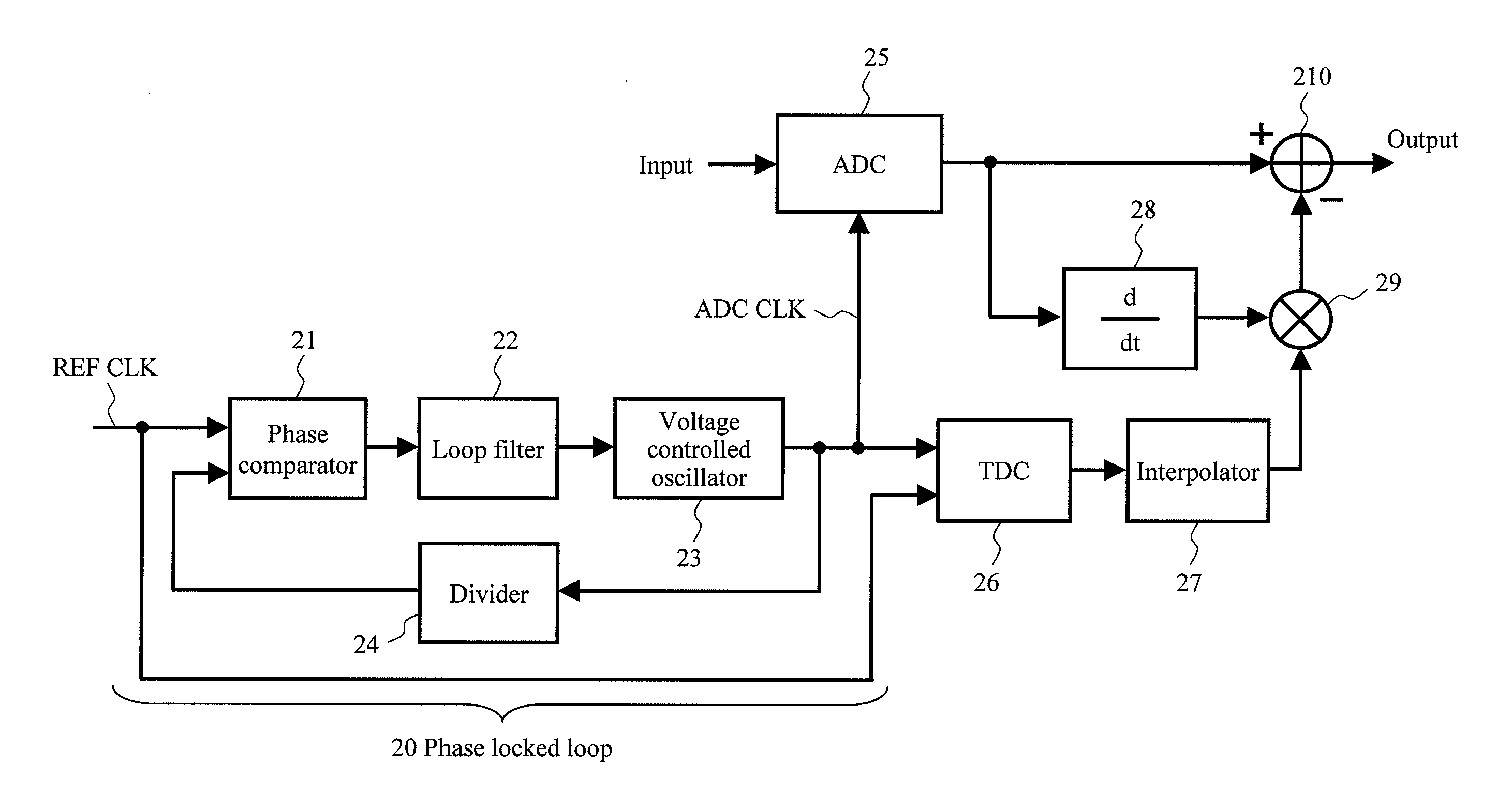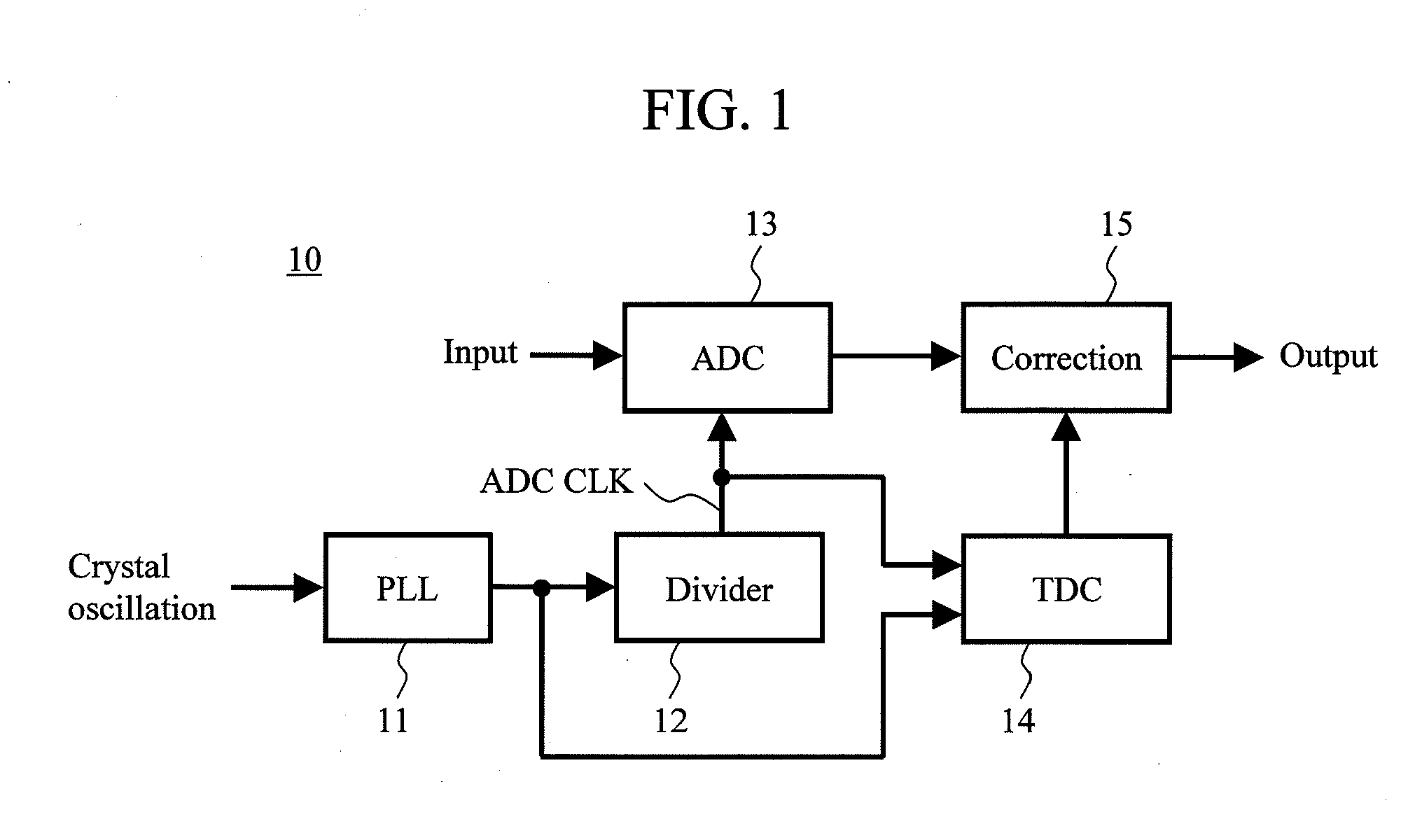Analog-to-digital converter and wireless receiver
a technology of analog-to-digital converter and wireless receiver, which is applied in the direction of code conversion, pulse technique, instruments, etc., can solve the problems of difficult to provide a low jitter clock at the high frequency of 1 gs/s and sufficiently low power consumption, and difficult to provide an ultrafast and high-resolution analog-to-digital converter
- Summary
- Abstract
- Description
- Claims
- Application Information
AI Technical Summary
Benefits of technology
Problems solved by technology
Method used
Image
Examples
first embodiment
[0049]FIG. 2 shows an example of a structure of an analog-to-digital converter according to a first embodiment. In the first embodiment, a sampling clock (ADC CLK) used in the analog-to-digital converter is generated in a phase locked loop (PLL) 20 using a reference clock (REF CLK) as a source oscillation.
[0050]The phase locked loop 20 includes a phase comparator 21, a loop filter 22, a voltage control oscillator (VCO) 23, a divider 24, and the like. Incidentally, the phase comparator 21 may be a phase frequency comparator, and a charge pump circuit may be provided between the phase comparator 21 and the loop filter 22. Generally, a low-pass filter is used as the loop filter 22.
[0051]The circuit structure of the phase locked loop 20 is commonly known. Accordingly, the phase locked loop 20 performs the normal operation that is commonly known. Specifically, the output of the voltage control oscillator 23 is synchronized with the phase of the reference clock. The output of the voltage ...
second embodiment
[0086]FIG. 8 shows an example of a structure of an analog-to-digital converter according to a second embodiment. The analog-to-digital converter, which has the same circuit structure as in the first embodiment except that the phase locked loop 20 according to the first embodiment is replaced by a circuit structure described later, will be explained in this embodiment. Specifically, the case where the phase locked loop 20 is replaced by a circuit composed of a duty adjustment unit (Duty) 81, a band pass filter (BPF) 82 connected to the output thereof, and a buffer 83 connected to the output thereof will be explained. The structures and operations of the analog-to-digital conversion unit (ADC) 25, the digital correction unit, the time-to-digital converter 26, and the interpolator 27 are the same as in the first embodiment.
[0087]FIG. 9 shows waveforms of outputs from the duty adjustment unit 81, the band pass filter 82, and the buffer 83. FIG. 9 shows the case where the frequency of th...
third embodiment
[0093]FIG. 10 shows an example of a structure of an analog-to-digital converter according to a third embodiment. The analog-to-digital converter, which has the circuit structure as in the first embodiment except that the phase locked loop 20 according to the first embodiment is replaced by a circuit structure described later, will be explained in this embodiment. Specifically, the case where the phase locked loop 20 is replaced by a circuit composed of a duty adjustment unit (Duty) 81, an injection locking oscillator 101 connected to the output thereof, and a buffer 83 connected to the output thereof will be explained. Thus, the structures and operations of the analog-to-digital conversion unit (ADC) 25, the digital correction unit, the time-to-digital converter 26, and the interpolator 27 are the same as in the first embodiment.
[0094]FIG. 11 shows waveforms of outputs from the duty adjustment unit 81, the injection locking oscillator 101, and the buffer 83. FIG. 11 shows the case w...
PUM
 Login to View More
Login to View More Abstract
Description
Claims
Application Information
 Login to View More
Login to View More - R&D
- Intellectual Property
- Life Sciences
- Materials
- Tech Scout
- Unparalleled Data Quality
- Higher Quality Content
- 60% Fewer Hallucinations
Browse by: Latest US Patents, China's latest patents, Technical Efficacy Thesaurus, Application Domain, Technology Topic, Popular Technical Reports.
© 2025 PatSnap. All rights reserved.Legal|Privacy policy|Modern Slavery Act Transparency Statement|Sitemap|About US| Contact US: help@patsnap.com



